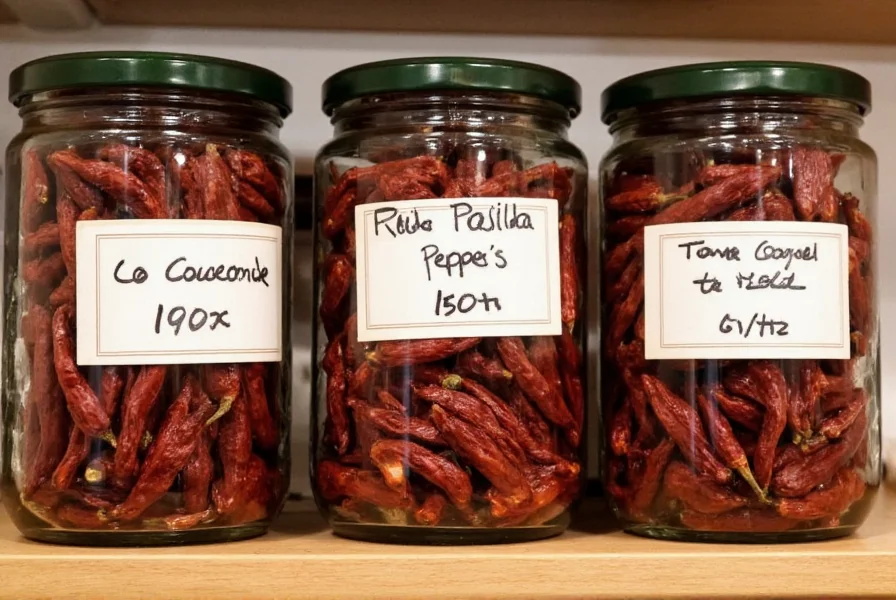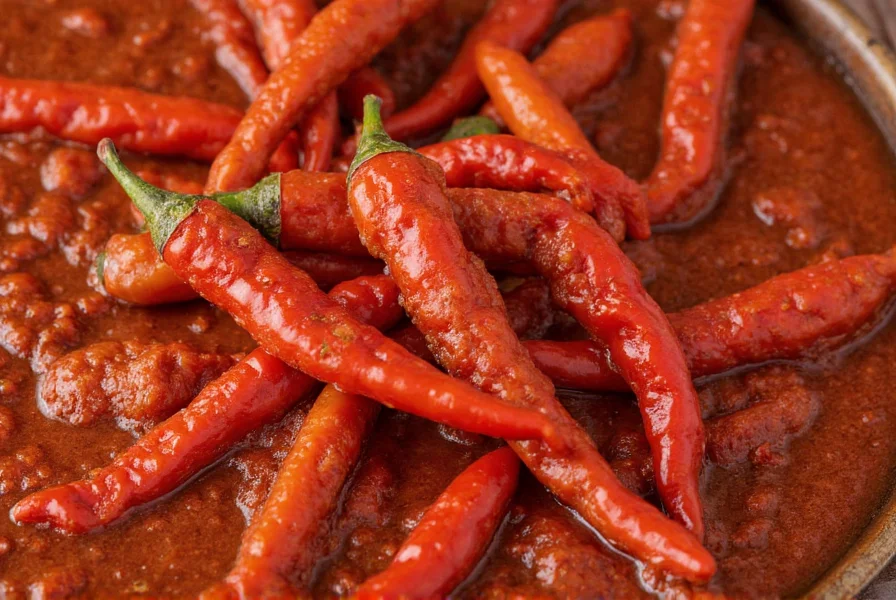Understanding the unique characteristics of chili pasilla helps home cooks and culinary professionals incorporate this versatile ingredient effectively. Unlike many dried chilies that transform dramatically from their fresh counterparts, pasilla maintains the chilaca's distinctive elongated shape and deep color, though it develops richer, more concentrated flavors during the drying process.
Identifying Authentic Chili Pasilla
When shopping for chili pasilla, look for these key identifying features:
- Appearance: Long (6-8 inches), narrow, deeply wrinkled with a dark brown to black color
- Texture: Thin, brittle skin that cracks easily when bent
- Aroma: Distinctive earthy, smoky scent with subtle notes of dried fruit and cocoa
- Internal structure: Contains numerous small, flat seeds that should be removed before use

Chili Pasilla vs. Common Confusions
Many shoppers confuse pasilla with other dried chilies, particularly ancho and mulato, which all originate from the same species (Capsicum annuum) but different varieties. This comparison clarifies the distinctions:
| Chili Type | Origin Pepper | Heat Level (SHU) | Flavor Profile | Common Uses |
|---|---|---|---|---|
| Pasilla | Chilaca | 1,000-2,500 | Earthy, smoky, raisin-like, subtle cocoa | Mole negro, sauces, stews |
| Ancho | Poblano | 1,000-2,000 | Sweet, dried fruit, tobacco notes | Mole poblano, adobo sauces |
| Mulato | poblano (fully ripe) | 2,500-3,000 | Chocolate, coffee, licorice undertones | Complex moles, marinades |
Culinary Applications of Chili Pasilla
Chili pasilla's complex flavor profile makes it indispensable in traditional Mexican cuisine, particularly in mole sauces where it provides the foundational earthy notes. Professional chefs and home cooks use pasilla peppers in several key ways:
Rehydration techniques: Proper preparation significantly impacts flavor extraction. For most applications, toast the dried peppers in a dry skillet for 20-30 seconds per side until fragrant but not burnt, then soak in hot water for 15-20 minutes until pliable. This process unlocks the maximum flavor while removing any dust or debris.
Traditional dishes featuring pasilla: Mole negro (Oaxacan black mole), chiles en nogada (when combined with other chilies), pipián sauces, and certain adobo preparations all rely on pasilla's distinctive flavor. The chili's moderate heat level allows its complex flavors to shine without overwhelming other ingredients.
Modern culinary adaptations: Contemporary chefs incorporate pasilla into unexpected applications like chocolate desserts, coffee rubs, and even craft cocktails where its fruity notes complement other ingredients. When using pasilla in non-traditional recipes, start with small quantities (1-2 peppers for 4 servings) and adjust to taste.
Effective Substitutions for Chili Pasilla
When authentic pasilla peppers aren't available, understanding appropriate substitutions preserves dish integrity. The best alternatives depend on whether you need to replicate flavor or heat:
- For authentic flavor replication: Combine ancho and mulato peppers (1:1 ratio) to approximate pasilla's complex profile
- For heat level matching: Guajillo peppers offer similar mild heat but different flavor notes
- For emergency substitutions: A blend of smoked paprika (1 tsp) and dried currants (1 tbsp) per pepper can mimic some characteristics in a pinch
Remember that pasilla's unique flavor cannot be perfectly replicated, so adjust other seasonings accordingly when substituting. Dishes requiring multiple dried chilies benefit from maintaining pasilla as a primary component while substituting others.
Storage and Preservation Methods
Proper storage maintains chili pasilla's flavor compounds and prevents spoilage. Follow these guidelines for optimal preservation:
Dried pasilla peppers should be stored in airtight containers away from light and moisture. In cool, dark pantries, they maintain peak quality for 6-8 months. For extended storage, freeze peppers in vacuum-sealed bags for up to 2 years. Check periodically for any signs of moisture or mold, which indicate compromised quality.

Nutritional Profile and Health Benefits
While primarily used for flavor rather than nutrition, chili pasilla offers several health-promoting compounds. Like all chili peppers, it contains capsaicin (though in modest amounts due to its mild heat), which has been studied for potential metabolic and anti-inflammatory benefits. Pasilla peppers also provide:
- Vitamin A (from carotenoids) supporting eye health
- Vitamin C (though reduced from fresh chilaca form)
- Dietary fiber when consumed with seeds removed
- Antioxidants including flavonoids and phenolic compounds
The drying process concentrates certain beneficial compounds while reducing others, creating a unique nutritional profile distinct from fresh chilaca peppers.
Where to Source Quality Chili Pasilla
Finding authentic pasilla requires attention to detail. Specialty Mexican markets typically offer the freshest inventory, recognizable by their deep color and flexible texture. When purchasing online, look for vendors who specify harvest dates and storage conditions. Avoid peppers that appear overly brittle or have a musty odor, as these indicate age or improper storage.
For gardeners interested in growing chilaca peppers, select varieties specifically labeled as chilaca rather than generic "pasilla" seeds, which often refer to different pepper types in commercial seed catalogs. The plants require 80-90 days to maturity and perform best in warm climates with well-drained soil.
What's the difference between chili pasilla and poblano peppers?
Chili pasilla is the dried form of the chilaca pepper, while poblano is a fresh pepper that becomes ancho when dried. Pasilla peppers are longer, thinner, and darker than poblanos, with more complex earthy and fruity flavors. Poblanos are heart-shaped and significantly milder when fresh.
Can I substitute ancho peppers for pasilla in mole recipes?
While ancho peppers can substitute for pasilla in a pinch, they create a noticeably different flavor profile. Anchos are sweeter with more pronounced dried fruit notes, while pasillas offer deeper earthy, smoky characteristics essential to traditional mole negro. For best results, use a 50/50 blend of ancho and mulato peppers to approximate pasilla's complexity.
How do I properly prepare dried pasilla peppers for cooking?
First, remove stems and seeds. Toast the peppers in a dry skillet over medium heat for 20-30 seconds per side until fragrant. Then soak in hot water for 15-20 minutes until pliable. This rehydration process extracts maximum flavor while removing any potential contaminants. Never skip the toasting step, as it significantly enhances the final dish's flavor complexity.
Why are my pasilla peppers extremely brittle and breaking apart?
Excessive brittleness indicates the peppers are either too old or were improperly stored with exposure to air and light. Fresh pasilla should have some flexibility when bent. While still usable, extremely brittle peppers have likely lost significant flavor compounds. For best results, purchase from vendors with high turnover and store in airtight containers away from light.
What dishes showcase chili pasilla's unique flavor best?
Traditional Oaxacan mole negro provides the most authentic showcase for pasilla's complex flavor profile. The chili's earthy, smoky notes form the foundation of this complex sauce. Pasilla also shines in chiles en nogada (when combined with other chilies), certain pipián sauces, and adobo preparations where its moderate heat allows its nuanced flavors to come through without overwhelming other ingredients.











 浙公网安备
33010002000092号
浙公网安备
33010002000092号 浙B2-20120091-4
浙B2-20120091-4